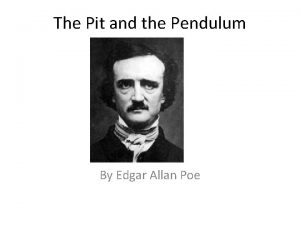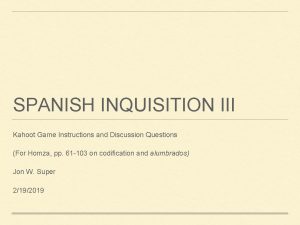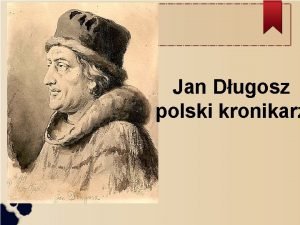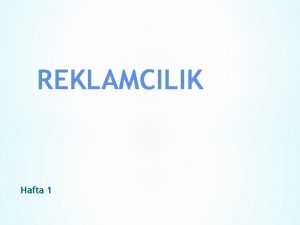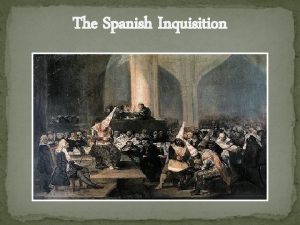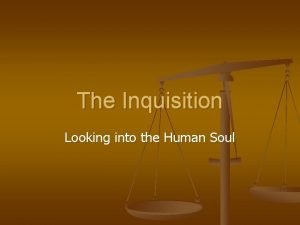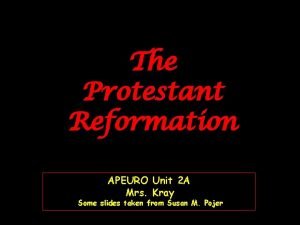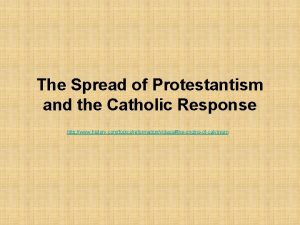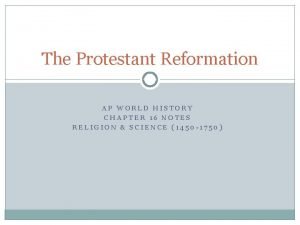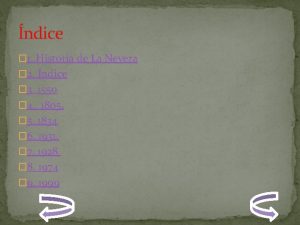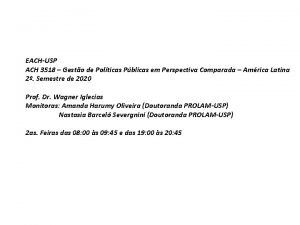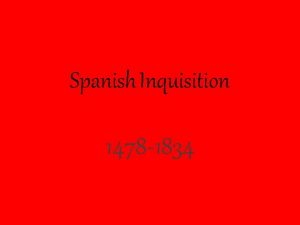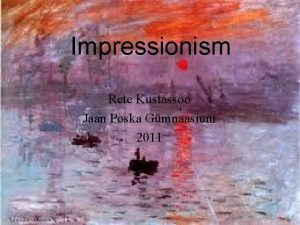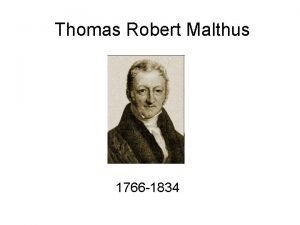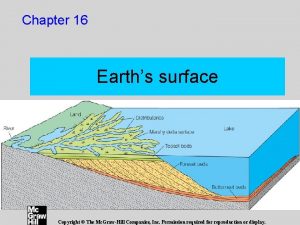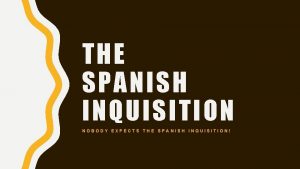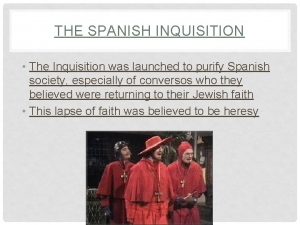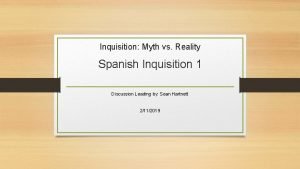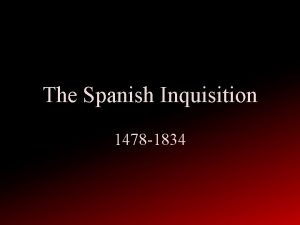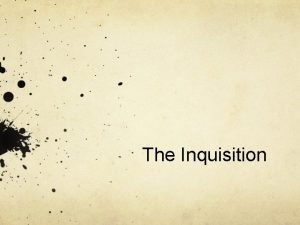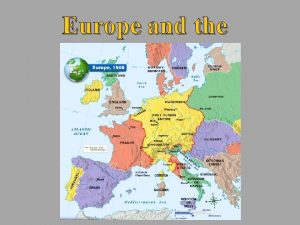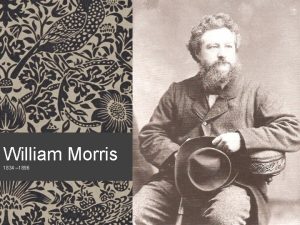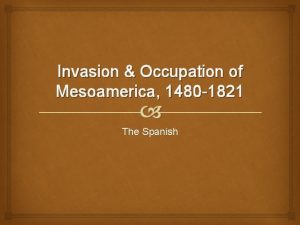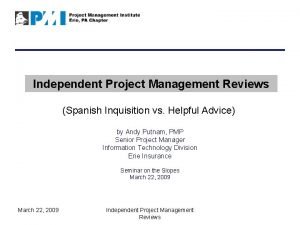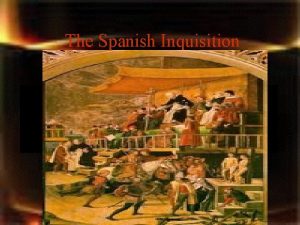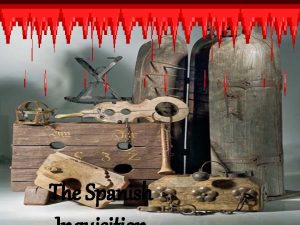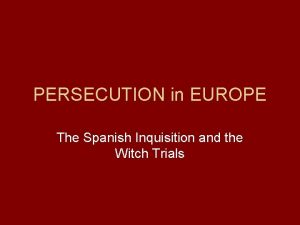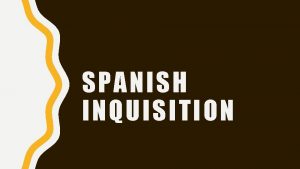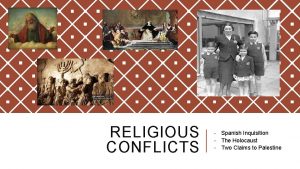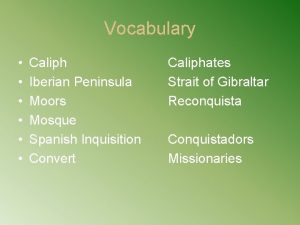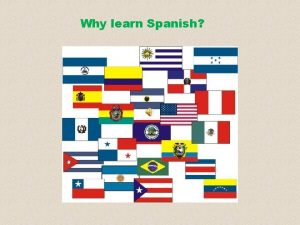Reactions to Protestantism Spanish Inquisition 1480 1834 What


























- Slides: 26

Reactions to Protestantism

Spanish Inquisition 1480 -1834

What was the Inquisition? • It was designed to unify the beliefs of Catholicism in Spain against the influence of Jews and Moors (Spanish Muslims) – They had just fought a war to remove Muslim influence – They wanted to solidify their power – People would gain prestige as becoming Moor fighters – Spanish rulers would reward those who would fight against the Muslims and Jews

What happened during the Inquisition? • It was a hunt to get rid of influences that were seen as unorthodox – People would turn other people in – Force conversion – Threaten families – Take away your property – Prison – Torture – Death

Trials • Accusations were anonymous – What positive aspects come from this rule? – What negative aspects come from this rule? • Edicts of Grace – You could confess and the punishment wasn’t very severe • Edicts of Faith – Left out the grace period and just put people on trial if they were accused

Outcomes of Trials • • • Acquittal – the accused was set free (rarely happened) Suspension - the accused went free (with the threat the process could be continued at any time) or was held in long-term imprisonment until a trial commenced. Penance – Since the accused were considered guilty, they could accept a public punishment such as exile, fines or even sentencing to the galleys. Reconciliation - In addition to the public ceremony in which the condemned was reconciled with the Catholic Church, long sentences to jail or the galleys, confiscation of all property, physical punishments. Relaxation - This penalty was frequently applied to who didn’t confess or to those who had gone back on their conversions. Execution was public. If the condemned repented, they were shown mercy by being strangled before burning; if not, they were burned alive.

Cases in the Spanish Inquisition 1540– 1700 Judaizers Moriscos Protestants All Others Total Relaxed 4, 397 10, 817 3, 646 25, 814 44, 674 1, 604 9. 8% 23. 2% 8. 1% 57. 8% 100. 0% 3. 5% Adapted from Jaime Contreras and Gustav Henningsen, "Fortyfour Thousand Cases of the Spanish Inquisition (1540– 1700): Analysis of a Historical Data Bank, " in Henningsen and Tedeschi, 116. Included in the category "All Others" are propositions and blasphemy (27. 1%), bigamy and solicitation (8. 4%), acts against the Inquisition (7. 5%), superstition (7. 9%), and various (6. 8%). The "Total Relaxed" involves only those sentenced to death in person.

Paintings and Drawings from the Inquisition

Paintings and Drawings from the Inquisition

Paintings and Drawings from the Inquisition

Paintings and Drawings from the Inquisition

Paintings and Drawings from the Inquisition

Paintings and Drawings from the Inquisition


Personal Life • Galileo was born in Pisa but later moved to Florence • His father was a musician • Galileo was never married but had three children – Both daughters entered the monastery – His son was eventually legitimized

Professional Life • He started with his father’s music education • He enrolled in the University of Pisa and started working towards a medical degree • He talked his father into letting him study mathematics and natural philosophy • Became a teacher in Florence in 1588 • Became the chair of Mathematics Department in 1589 • Moved to the University of Padua in 1592


Professional Life • Theory on Tides that was based on the idea of the earth’s rotation (was disproved) • Comet Controversy – Jesuit Priest named Father Grassi • Thought that the comet was a fiery body • Thought it was more distant than the moon – Galileo wrote a response through one of his students named Guiducci • Didn’t offer a theory on comets but offered some ideas on what they are (have been disproven) • Work had veiled insults and derogatory comments about the Professor at the College of Romano

Effects of Galileo’s Work • Jesuits were insulted and discredited • Pope Urban VIII liked his work especially the work on the comets

Heliocentric vs. Geocentric Theory • Geocentric evidence – Biblical Verses (Psalm 93: 1, 1 Chronicles 16: 30, Psalm 104: 5, Ecclesiastes 1: 5) – Historical outlooks by most cultures • Heliocentric evidence – Path that planets move across the sky


Problem of Retrograde • Planets didn’t move like they should if Geocentric theory was correct

Galileo vs. Church • Galileo goes to Rome to convince the Church that it was wrong on Copernicus • Galileo was arguing that scripture and science weren’t contradicting each other they were just talking about different movements • Church issued a statement saying that the idea of the Earth moving and the Sun staying still was against scripture

Effects of Controversy • Galileo promised to change his opinions • In his writings it comes out that he hasn’t changed his opinions • Galileo is ordered to stand trial after he continues to try to persuade people • Galileo is convicted and is charged: – Suspicion of Heresy and ordered to recant his beliefs – Imprisoned for the rest of his life – His works are banned including future works

Death • Galileo was put in charge of the Church but was allowed to continue his work • He died at age 77 after a fever and heart issues • He was buried in Pisa next to his father and other ancestors in the Basilica of Santa Croce – Since he was condemned it is a small room next to everyone else

 Irony in the pit and the pendulum
Irony in the pit and the pendulum Kahoot instructions
Kahoot instructions Jan kronikarz zm.1480 r
Jan kronikarz zm.1480 r 1480 de ilk duvar afişi
1480 de ilk duvar afişi What was the inquisition
What was the inquisition The inquisition definition
The inquisition definition Lutheran vs catholic
Lutheran vs catholic Protestant vs catholic
Protestant vs catholic Catholic responses to protestantism
Catholic responses to protestantism Protestant reformation ap world history
Protestant reformation ap world history Section 2 classifying chemical reactions
Section 2 classifying chemical reactions Chemistry unit 5 reactions balancing reactions worksheet
Chemistry unit 5 reactions balancing reactions worksheet How to write half reactions
How to write half reactions Chemical reactions section 2 classifying chemical reactions
Chemical reactions section 2 classifying chemical reactions Types of reactions
Types of reactions Refrigerador 1834
Refrigerador 1834 1834 zollverein
1834 zollverein John venn (1834-1923)
John venn (1834-1923) 1834-1839
1834-1839 1834-1478
1834-1478 Prantsuse maalikunstnik 1834-1917
Prantsuse maalikunstnik 1834-1917 It must be love of fatherland that governs
It must be love of fatherland that governs 1834 poor law
1834 poor law Thomas robert malthus (1766-1834)
Thomas robert malthus (1766-1834) 1834 constitucion
1834 constitucion Spanish packet answers
Spanish packet answers Chemical reactions in soil
Chemical reactions in soil
